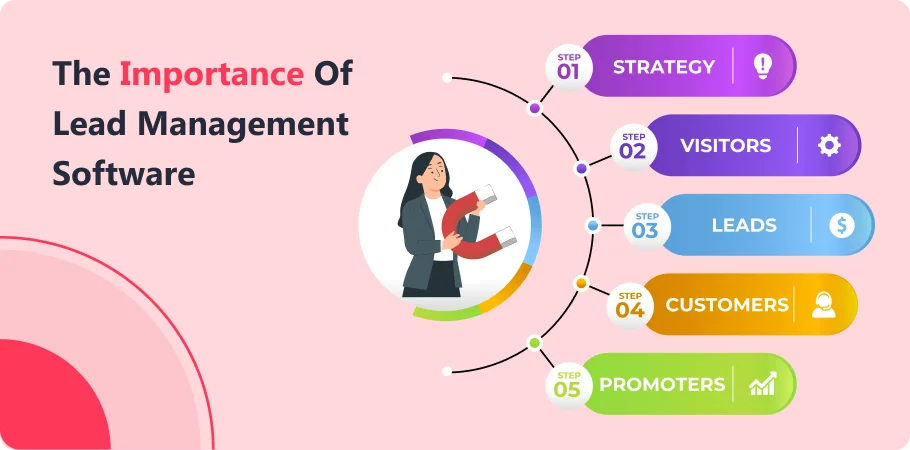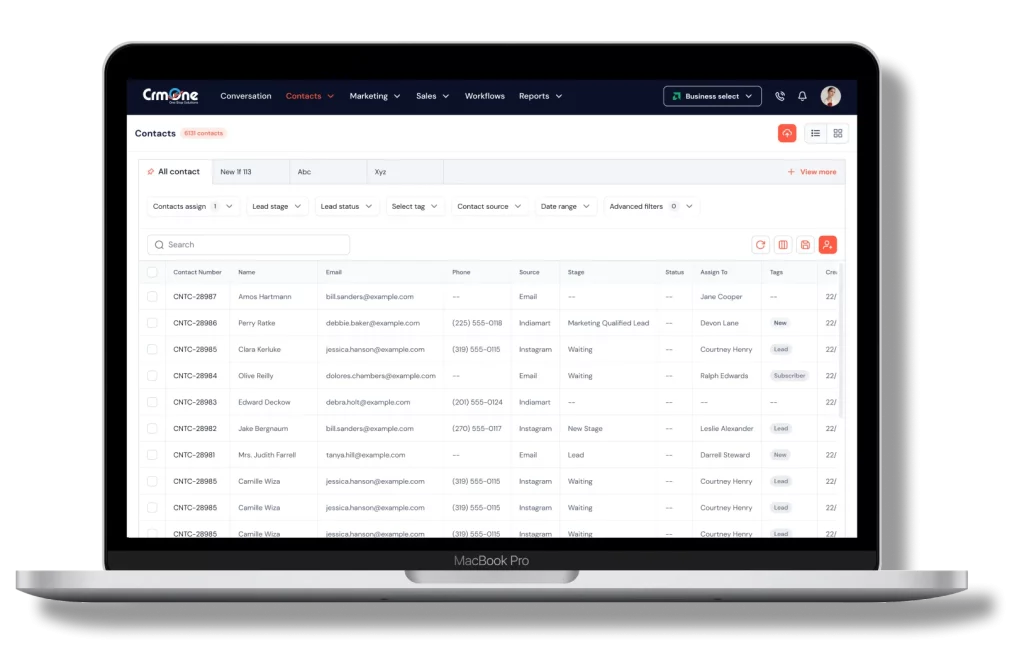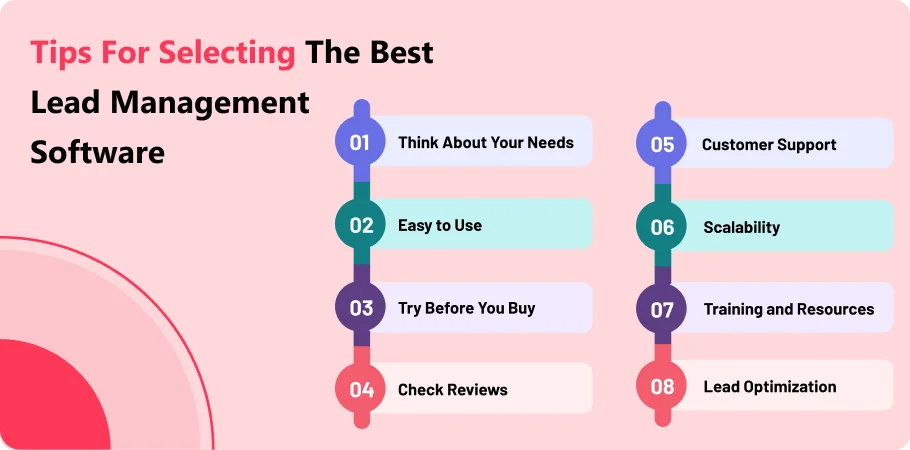In today’s bustling digital landscape, businesses face the challenge of efficiently managing potential customers, or leads, to convert them into loyal buyers. Lead management software emerges as a pivotal solution in navigating this complex terrain. However, selecting the ideal software can be daunting amidst a plethora of options. That’s where our guidance comes in.
We’ll delve into key considerations for choosing lead management solutions, empowering you to make informed decisions tailored to your organization’s needs. Selecting the right lead management systems is paramount for any business, irrespective of tenure. The right tools simplify lead monitoring, enabling seamless communication that resonates with potential buyers, thereby fostering stronger connections.
Effective lead management software facilitates lead generation through features like customizable forms and pages, ensuring visibility across various platforms, including websites and social media. Moreover, the software aids in lead qualification, identifying high-potential prospects that warrant prioritized attention from marketing and sales teams. Central to the efficacy of lead management systems is its ability to drive data-driven decisions.
By tracking lead sources and analyzing acquisition rates, businesses gain insights into their sales cycle, empowering sales representatives to tailor their approaches for optimal results. Leveraging tools like Google Ads further enhances lead generation efforts, while educational content and targeted landing pages enhance engagement and conversion rates. Through collaborative efforts and integration with marketing teams, businesses can harness the full potential of lead management software to navigate the evolving digital landscape successfully.
What is Lead Management Software?

Lead management software is a special tool that helps businesses keep track of people who might buy their products or services. It’s like having a helper who organizes all the information about these potential clients. This tool is really important because it helps businesses make sure they’re talking to the right people at the right time.
With lead tracking software, businesses can easily see where each potential customer is in the process of buying something. It’s like having a map showing which clients are almost ready to buy and which ones need more time. This helps businesses know who to talk to first and how to help them decide.
The software also helps businesses save time by automatically giving each potential customer to the right salesperson. This means the sales team can focus on talking to clients instead of trying to figure out who to call next.
The best part is that the software helps businesses see which ads or marketing campaigns bring in the most clients. This way, companies can spend their money on the best things, making selling their products or services easier.
The Importance of Lead Management software

Effective lead management is essential for businesses to maximize their sales opportunities and revenue potential. By implementing a robust lead management system, businesses can.
Improved Collaboration:
Improved collaboration is a significant advantage of utilizing right lead management software. This lead tracking software facilitates seamless coordination among various teams within a company, such as sales, marketing, and customer service. Firstly, it ensures everyone can access the same information about leads, promoting transparency and alignment across departments. This shared visibility lets team members stay informed about the latest updates and interactions with leads, enhancing collaboration and decision-making.
Read management software simplifies communication by providing a centralized platform for teams to exchange messages, updates, and feedback. Rather than relying on scattered email threads or phone calls, teams can communicate directly within the software, fostering more efficient collaboration. This streamlined communication ensures that important information is readily accessible to all team members, leading to quicker responses and resolutions.
lead tracking software promotes standardized workflows and collaborative lead nurturing efforts. By following predefined processes and sharing resources, such as marketing content and sales insights, teams can effectively engage and nurture leads.
This collaborative approach enhances the overall lead managing process, enabling teams to leverage each other’s strengths and expertise for better outcomes. Ultimately, improved collaboration through lead management software empowers teams to work cohesively toward achieving common goals and driving business success.
Scalability and Growth:
Scalability and growth are essential benefits of using lead management software. This means the software can grow and adapt as a company grows and needs change. Here’s why it’s helpful:
Firstly, as a company grows, it gets more leads to manage. Lead management software can handle this increase by organizing and tracking more leads without slowing down or getting overwhelmed. It’s like having a giant basket to hold more fruits as the tree grows taller.
Secondly, a company’s needs can change over time. Lead management software is flexible and can be adjusted to meet these changing needs. For example, new features can be added, or settings can be changed to fit the company’s evolving requirements. It’s like upgrading a tool to improve it as you learn how to use it.
Lastly, lead management software can grow alongside a company’s success. As the company attracts more customers and expands its operations, the software can support these growth initiatives by providing additional features or accommodating higher volumes of data. It’s like having a trusted partner who grows with you, helping you every step of the way.
Overall, scalability and growth are essential aspects of lead management software that ensure it remains valuable to a company as it progresses and achieves its goals.
Increase Efficiency:
Companies leverage lead tracking software to enhance efficiency in generating leads, which facilitates streamlined processes. This software enables centralized lead acquisition, tracking, and nurturing, reducing the need for manual tasks. Businesses can efficiently manage their leads by automating these processes, ensuring timely follow-ups and personalized interactions. This improved efficiency accelerates the lead-to-customer journey and optimizes resource allocation, empowering teams to focus on high-potential clients and maximize conversion rates.
Centralized Lead Tracking:
Centralized lead tracking is an essential feature of lead tracking software. It means that all information about leads is kept in one place, making it easy for everyone on the team to see and use. Here’s why it’s helpful:
Having all lead information in one central location saves time. It prevents confusion. Team members don’t have to search different files or systems to find what they need. It’s like having all your toys neatly organized in one big toy box so you can find them quickly when you want to play.
Secondly, centralized lead tracking promotes consistency and accuracy. Since everyone uses the same system, there’s less chance of information getting lost or duplicated. This helps teams work together more smoothly and ensures everyone is on the same page. It’s like following the same map to reach a destination so no one gets lost.
Lastly, centralized lead tracking enables better decision-making. With all available lead data, team members can analyze trends, identify opportunities, and make informed choices about approaching leads. This leads to more effective strategies and, ultimately, better results. It’s like having a clear view of the road ahead so you can plan your journey wisely and confidently reach your destination.
Centralized lead tracking is a valuable feature of lead tracking software that promotes efficiency, consistency, and informed decision-making, helping teams achieve their goals more effectively.
Improve Lead Quality:
Leading quality is essential for firms aiming to maximize their sales potential. By targeting qualified prospects, businesses can streamline their efforts and focus on individuals more likely to convert into clients. Effective lead qualification techniques ensure that resources are allocated efficiently, leading to higher conversion rates and increased revenue.
By identifying and nurturing qualified leads, businesses can optimize their sales process and achieve greater success. Understanding potential consumers’ buying processes is crucial in this optimization effort. By aligning lead qualification strategies with each stage, businesses can tailor their approach to meet prospects’ specific needs and preferences, ultimately guiding them toward making a purchase decision.
Lead Scoring and Prioritization:
lead tracking software allows businesses to assign scores to leads based on their level of engagement and likelihood to convert. This helps sales teams prioritize their efforts on leads most likely to result in sales, maximizing efficiency and productivity.
Enhance Customer Experience:
Implementing CrmOne and Zoho CRM can significantly enhance customer experience by streamlining processes and providing a seamless interaction journey. With CrmOne, businesses can efficiently manage customer information, track interactions, and personalize communication, improving customer satisfaction and loyalty.
By automating repetitive tasks and centralizing customer information, CrmOne saves teams time, allowing them to focus more on delivering exceptional service and building meaningful relationships with consumers. Integrating CrmOne into the workflow can elevate the customer experience to new heights.
Data-Driven Insights:
Lead management software generates valuable insights through analytics and reporting features. Businesses can track key metrics such as lead conversion rates, sales pipeline velocity, and campaign performance. These insights enable data-driven decision-making, allowing companies to optimize their lead generation and conversion strategies for better results.
Optimize Sales Performance:
To optimize sales performance, businesses must strategically streamline their activities to maximize efficiency and effectiveness. By carefully orchestrating sales activity, teams can ensure they invest their time and resources wisely, focusing on high-potential opportunities and nurturing relationships with prospects. This targeted approach enhances productivity and increases the likelihood of securing valuable deals and achieving sales targets in a cohesive effort.
Evolution of Lead Management
Lead management has evolved significantly over the years, adapting to changing technologies and practices. Here’s a breakdown of its evolution:
Traditional Lead Management Methods
In the past, lead management relied heavily on manual processes and paper-based systems. Businesses kept track of leads using handwritten notes, spreadsheets, or essential databases. Lead information was often scattered and disorganized, making it challenging to follow up effectively.
Rise of CRM Systems
Customer Relationship Management Systems became more sophisticated, offering comprehensive lead management capabilities. These systems allowed businesses to capture, track, and analyze information on leads more effectively—integration with other tools, such as email marketing platforms, improved communication, and follow-up with leads.
Key Features to Consider

When evaluating lead management software, consider the following features to ensure it meets your business requirements:
Lead Capture
Lead capture is a unique tool that helps businesses find out about people who might be interested in what they’re selling. It’s super essential for keeping track of these potential customers. A good lead tool should let businesses make their forms and pages look nice and match their company’s style. These forms should be easily changed and put on different parts of the internet, like websites or social media.
Another cool thing is that these tools can help businesses learn more about the people who are interested in their stuff over time. They can also offer unique things, like free books or videos, to get people’s attention and ask for their contact info in return.
The forms and pages should be easy to understand and should ask for only the most essential information. They should also follow the rules about keeping people’s information safe and private. And it’s fantastic if these tools can work with other tools that businesses use, like keeping track of customer info or sending out emails.
Additionally, it ensures that the information collected is compliant with data privacy regulations and automatically assigns leads and qualifies them. In the end, using good tools helps businesses find and talk to the right people, which can help them grow and succeed.
Lead Tracking
It is a feature within lead management software that is vital for businesses to monitor and manage their interactions with potential customers throughout the selling process. This feature lets companies keep a detailed record of every interaction with leads, from initial contact to conversion or loss. With it, businesses can capture essential information such as lead demographics, communication history, and engagement metrics, providing valuable insights into lead behavior and preferences.
By tracking leads effectively, businesses can identify where leads are in the sales funnel, prioritize follow-up actions, and tailor their communication strategies to better meet leads’ needs. Additionally, it enables marketing and sales teams to collaborate more efficiently by providing visibility into lead status and activities, facilitating seamless handoffs between team members.
Furthermore, advanced lead monitoring capabilities, such as lead scoring and activity tracking, allow businesses to identify high-value leads and focus their efforts on prospects with the most significant potential for conversion. Overall, the leads monitoring feature empowers businesses to effectively manage their leads, optimize their sales processes, and ultimately drive growth.
Lead Distribution
Lead distribution like a traffic director for potential clients, ensuring they reach the right salesperson at the right time. This feature is crucial for businesses with multiple sales reps or teams, as it helps distribute leads fairly and efficiently among them.
Think of it as a sorting hat but for leads! When a new lead comes in, this feature automatically assigns it to the most suitable sales rep based on predefined criteria. These criteria could include geographic location, product expertise, or workload.
By automatically assigning leads, the software ensures that no leads fall through the cracks and that each gets the attention it deserves. This saves time and maximizes the chances of converting leads into paying customers.
Additionally, it helps balance the workload among sales reps, preventing some from overloading while others have too few leads. This ensures that each salesperson can focus on nurturing their assigned leads effectively. Overall, it is a valuable tool for optimizing the pipeline management process, improving sales efficiency, and ultimately driving success.
Lead Nurturing
Nurturing leads is a vital feature in lead management software. It is like taking care of a plant to help it grow big and strong. In the same way, nurturing leads in best lead management software helps businesses take care of their potential customers or leads, making them more likely to become buyers in the future.
With it, businesses can send helpful and friendly messages to their leads over time. These messages might include tips, information, or special offers that make the leads more interested in what the business offers. It also helps businesses keep track of their interactions with leads. This way, they can see which leads are most interested and which might need more attention.
Overall, lead management software is essential because it helps businesses build strong relationships with their leads over time, increasing the chances of turning them into loyal customers. It’s a necessary part of any lead management strategy to ensure that leads are nurtured throughout the lead management process to become buyers eventually.
Lead Qualification
Lead qualification is crucial, ensuring that the sales team prioritizes their efforts to engage with prospects who are most likely to convert into buyers. By thoroughly evaluating prospects against predefined criteria, businesses can identify qualified leads that exhibit genuine interest and purchasing intent. These qualified leads represent valuable opportunities for the sales team to focus their resources and attention, increasing the likelihood of successful conversions.
Moreover, by consistently refining the criteria for qualified leads based on feedback and data analysis, businesses can continuously optimize their qualifying leads process to generate high-quality leads and drive tremendous sales success. Qualifying leads ensures that sales teams invest their time and resources wisely, focusing on genuinely interested prospects who are ready to purchase.
This targeted approach improves the efficiency of the selling process and maximizes the chances of closing deals. By establishing clear criteria for qualifying leads and regularly reviewing and updating these criteria, businesses can ensure that their sales teams consistently pursue the most promising growth opportunities.
Sales Process Automation
It is like having a helpful robot friend who helps you sell things. Imagine you have a list of things you must do daily, like sending emails or keeping track of who you talked to. With automation, this robot friend does all those tasks for you. It sends emails automatically and keeps your list updated without you needing to do anything.
And you know when you sometimes forget to follow up with someone? Automation helps with that, too! It reminds you when it’s time to check back in with someone so you never miss a chance to make a sale.
Even though the robot sends messages automatically, they still feel like they’re just for you. That’s because you can make each message memorable for the person you’re sending it to. It’s like sending a note to a friend, but the robot helps you write it.
Overall, automation makes selling things easier and faster. It helps you keep track of things, talk to clients, and sell more without working too hard. It’s like having a super robot friend that enables you to make more money!
Integration Capabilities
Ensure smooth data flow and collaboration across teams by integrating with various business systems like CRM platforms, marketing automation tools, and lead generation software. This integration guarantees seamless connectivity, allowing information to move effortlessly between systems. By incorporating these tools into your workflow, you can streamline processes and enhance productivity. This collaborative approach ensures that all teams have access to up-to-date information, enabling them to work more efficiently towards common goals.
Reporting and Analytics
Lead management software’s reporting and analytics feature is a unique tool that helps businesses understand how well they do with their customers. It’s like having a report card that shows how many they’ve talked to and how many have bought something.
With this feature, businesses can see important information, like where they came from and how they found out about the businesses. This helps them know which promotion initiatives are working and which need improvement.
The reporting and analytics feature also helps businesses see how many are buying something and how much money they make. This lets them know if they’re doing an excellent job selling their products or services.
Overall, the reporting and analytics feature is a helpful tool that gives businesses important information about their customers and helps them make better decisions about selling their products or services. It’s like having a super-smart assistant that helps them understand their customers better and sell more effectively.
Book a CrmOne Demo
Experience the CrmOne simplicity and power. Our experts will show you the best ways to use it and answer your questions in real time. See how CRMOne fits your needs.

Tips for Selecting the Best Lead Management Tools

Here are some simplified tips for selecting the best lead management tools:
- Think About Your Needs: Consider what you need. Do you need help finding leads, organizing them, or both?
- Easy to Use: Look for software that’s easy to understand and use. You want something simple!
- Try Before You Buy: See if you can try the software before buying it. That way, you can make sure it works well for your organization.
- Check Reviews: Look at what other people say about the software. If lots of people like it, that’s a good sign!
- Cost: Make sure the software fits your budget. Some options might be too expensive for what you need.
- Customer Support: Check if the software comes with good customer support. It’s nice to have help if you get stuck!
- Integration: If you use other tools, ensure the software can work with them. Everything must work together smoothly.
- Security: Make sure the software keeps your information safe. You want your customer information to be in the right hands!
- Scalability: Think about the future. Will the software still work well as your organization grows?
- Training and Resources: Check to see if the software offers training or resources to help you get the most out of it. It’s always good to have some extra help!
By keeping these tips in mind, you can find the best lead management tools for your businesses and make managing leads a breeze!
Case Studies and Examples

To illustrate the effectiveness of lead management software, here are some real-life examples of businesses that have successfully implemented it:
Company A:
By implementing other lead management tools, Company A was able to increase its lead conversion rate by 30% and achieve a 20% increase in sales revenue within six months.
Company B:
With the help of lead tracking and analytics features, Company B identified key trends in its lead acquisition rates and adjusted its marketing campaigns accordingly, resulting in a 25% improvement in lead quality.
Company C:
By automating lead distribution and assignment processes, Company C reduced its response time to incoming leads by 50%, leading to a significant increase in sales opportunities and customer satisfaction.
Common Challenges and Solutions

Here’s a breakdown of common challenges in lead management system and possible solutions:
Data Quality Issues
Challenge: Inaccurate or incomplete lead information can hinder effective lead management and lead to wasted time and resources.
Solution: Implement data validation processes to ensure the accuracy and completeness of lead information. Use automated cleansing tools to identify and correct errors.
Alignment Between Sales and Marketing
Challenge: Misalignment between sales and marketing teams can result in leads being handled and addressed, leading to missed opportunities.
Solution: Foster collaboration and communication between sales and marketing teams by establishing shared goals, processes, and metrics. Implement a lead scoring system that both teams agree upon to prioritize leads effectively.
Scalability:
Challenge: As a business grows, managing an increasing volume of leads can become overwhelming and inefficient.
Solution: Choose a lead management tools that can scale with your organization’s needs. Look for automation and workflow management features to streamline lead management processes and accommodate growth.
Lead Nurture and Engagement:
Challenge: Keeping leads engaged throughout the buying journey can be challenging, especially with longer sales cycles.
Solution: Develop personalized campaigns for nurturing leads based on lead interests, preferences, and behavior. Utilize automation tools to deliver targeted content and follow-up messages at the right time.
Integration Challenges:
Challenge: Integrating lead management tools with existing systems and tools can be complex and time-consuming.
Solution: Choose the best lead management software that offers seamless integration capabilities with other organization systems, such as CRM, marketing automation, and analytics tools. Prioritize solutions that provide pre-built integrations and support for custom integrations if needed.
Measuring ROI and Effectiveness:
Challenge: It can be challenging to measure the return on investment (ROI) and effectiveness of lead management efforts.
Solution: Implement tracking mechanisms and analytics tools to monitor key performance indicators (KPIs) such as lead conversion rates, leads, and pipeline velocity. Regularly review and analyze information to identify areas for improvement and optimize lead management strategies.
Adapting to Changing Market Dynamics:
Challenge: Market dynamics and customer preferences constantly evolve, requiring businesses to adapt their lead management strategies accordingly.
Solution: Stay informed about industry trends and changes in customer behavior. Monitor and analyze lead data to identify patterns and trends and adjust lead management strategies accordingly.
Conclusion
In conclusion, lead management tools such as CrmOne are vital in helping businesses streamline their lead management processes, maximize sales opportunities, and achieve revenue goals. By considering the key features outlined in this guide and selecting a solution that meets your needs, you can empower your sales teams to effectively capture new leads, qualify leads, and track and nurture leads, ultimately driving organizational growth and success. The right sales rep effectively enhances the overall sales cycle.
Whether a small startup or a large enterprise, investing in the other lead management tools can make all the difference in your sales performance and overall success, so take the time to evaluate your options, prioritize your requirements, and choose a solution that will set your organization up for long-term success. If you’re ready to take your lead management to the next level and unlock new growth opportunities, explore your options today!
Get started for Free
Start for free today. Boost your sales by clicking the Get Started button. With CrmOne, you can manage leads, sales, and customer service all in one place.

